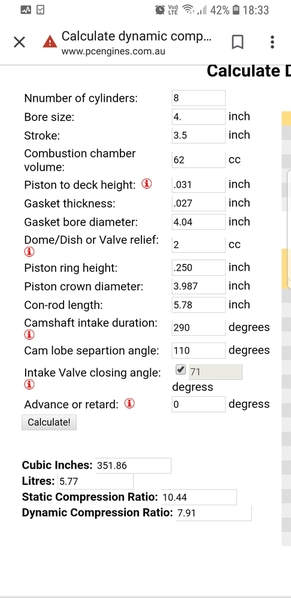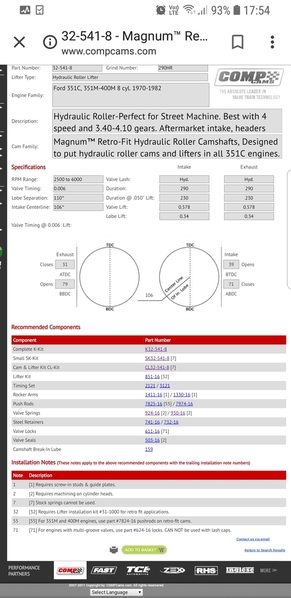Replies sorted oldest to newest
Also AFD aluminium heads 2v
what head gaskets are those, .027" x 4.04" ?
single pattern cam, make / grind number?
i can't say i see anything that looks out of order,
Wallace confirms 7.9:1 DCR
Static compression ratio of 10.44:1
Effective stroke is 2.56 inches
Your dynamic compression ratio is 7.90:1
Your dynamic cranking pressure is 160.88 PSI
Thanks for commenting. Afd aluminium heads .027 x 4.04 gasket camshaft
specs are below 290hr from comp. Edelbrock performer manifold 1 3/4 y type
extractor with 750 holley. Fmx 3000 stall 3.25 9" diff.
Do you think the compression is to low with 95 octane fuel? I'm in
Australia. Joined this forum because it's the best on Cleveland 351
Attachments
95 octane by RON, MON or AKI ?
your system is different than our Ron + Mon / 2 (average), IIRC the 95 number would be the higher of the 2 Ron / Mon and the other number would average it down to be close to our 91 Premium? and your 98 would be our 93 Super Premium?
i think George knows the international gasoline conversion a little better than i'm familiar with it. what i want to know is how some of our mates get away with insane static CR's and relatively mild cams? combos that should shake themselves apart in short time ...
the 71* intake close number at .006" will actually be a degree or two later for the valve to make the seat, not sure how much it matters but the difference only adds to the safety margin.
but Yes this is a low stress board that will only deliver straight info, it's nice ![]()
95 octane in Australia is equivalent to 91 octane in the US/Canada.
Dynamic compression in the range of 7.8:1 (maybe 8.0:1) is good with that gasoline; and basically the limit with a production block.
4V&Proud
Some folks run the dynamic compression out to ~8.25:1 and get away with it. Personally I prefer a margin for error.
Scott
The 3 things I'm looking at are the intake valve opening early at 39°BTDC, the excessive 70° of overlap, and the rising torque curve that 110° LSA will create. The engine characteristics will make the car a rough idling, dry weather only, weekend cruising car. I'm curious just how that fits in with how you intend to use the car. The manifold vacuum may not be enough for the FMX auto trans or the power brake booster. The car will need stout gears (3.91:1?) and the 3000 rpm torque converter you mentioned is about right.
Thanks for the honest replies. It is a weekend fun car. More so driving to a friend's place for beers on the weekend. I was planing on one 400 mile drive each way next year. I'm a little worried now about the vacuum. . . . The cam I bought is not in yet and I do have a chance to change it..... any suggestions??? I'm looking for a healthy 400 + at the flywheel. Please remember that it has afd aluminium heads too.
https://en.wikipedia.org/wiki/..._rating#cite_note-23
95 RON Australia = 90 AKI USA & Canada
reason i asked about the head gasket brand / part number is .027" is very thin, at 10.44:1 you don't need to pull every trick in the book for more static CR. by switching to Fel-Pro 8347 gaskets at .047" compressed it drops your static CR down to 9.95:1 and gets you more safety margin mentioned above. Edelbrock 7328 gaskets at .038" make 10.15:1
by changing the cam to the next smaller Comp 284HR and using the Fel-Pro 8347 gaskets your DCR is 7.75 and overlap is down to 64* which might just work with your existing rear gear?
but knowing how George feels about Comp cams in general, and his understanding of what makes a Cleveland cam i'm sure he can work up a custom grind that will shine if you're so inclined ...
Ford xc posted:The cam I bought is not in yet and I do have a chance to change it..... any suggestions??? I'm looking for a healthy 400 + at the flywheel.
I consider the cam below the best off the shelf street performance cam for an engine with 2V heads and 3.500 inch stroke. The cam has 112° lobe centers, I would prefer 114° lobe centers, but it gets the IVO and overlap in the ball park, the engine will have enough vacuum for the FMX and power brakes. Peak horsepower will occur at about 5500 rpm.
Crane Cams HR224 (part number 529551)
Hydraulic roller tappet camshaft
286°/294° duration at 0.004 (advertised)
280°/288° estimated duration at 0.006
224°/232° duration at 0.050
0.586/0.609 gross valve lift at 1.73:1 rocker ratio
LSA = 112° Overlap = 60° (based upon estimated duration)
Intake lobe centerline ℄ = 111° ATDC
The lobes are asymmetric thus the intake lobe “max-lift” occurs at 107° ATDC
______________________________________
Seated valve events (based upon estimated duration)
EVO = 77° BBDC
IVO = 29° BTDC
EVC = 31° ATDC
IVC = 71° ABDC
_____________________________________
Cam Timing: advance this camshaft 2°
Intake lobe centerline ℄ = 109° ATDC
Intake lobe “max-lift” = 105° ATDC
Thus advanced the intake valve will close at 69° ABDC.
Set the compression ratio at 10.2:1 or less (equivalent to 7.8:1 dynamic compression).
_____________________________________
Thanks so much for your email.
Sorry if I'm repeating my self but I just want to make sure you know all
the specs. I'll try to be brief.
Fresh engine
Standard 4" bore bottom end no Arp studs
Pistons .031 tho down from deck
Afd aluminium heads 2v 3c
Decked to 62cc chambers
Edelbrock performer manifold (I might up grade)
750 holley dp square bore with a little work done to it.
Compression worked out below.
1 3/4 extractor
2 1/2 system
Fmx 3000 stall
3.25 9" diff lsd
26" diameter rear wheels
Car is around 3800 pounds 1800kg
Do you still recommend the
Crane 224hr camshaft ????
Please remember that I'm in Australia
Off the shelf is better for me.
Thanks in advance.....
This is a great site for information.
Attachments
If it were me I'd do 5 things differently. I'd use the Crane HR224 cam which better matches the auto trans AND the high gearing you prefer, I'd set the compression as I expressed previously, select a different carburetor to better match the auto trans and the unheated intake manifold, install lower gearing (at least 3.50:1) , and use a different torque converter (matched to the gearing and the camshaft).
Depending upon the rev limit I'd select a carburetor rated 600 to 680 cfm or 735 to 780 cfm (when measured using the same criteria used by Holley Carburetors). I'd use the smaller carb if I'm setting the rev limit at 6200 rpm, or the larger carburetor for higher rev limits (6600 or 7200 rpm). The engine blows through a 6200 rpm rev limit too easily with the larger carb, so the smaller carb helps keep the engine under 6200 rpm when that's the rev limit.
The carb differs from the 750 double pumper you mentioned in three ways: its equipped with annular booster venturis, vacuum secondaries, and an electric choke. The annular boosters will atomize the fuel better since the AFD heads can't supply exhaust heat to the intake manifold. The vacuum secondaries are a better match with the automatic trans, the weight of the vehicle … and the gears you've selected. In general vacuum secondaries are a better match for street driven vehicles, providing smoother operation.
600 to 680 carbs
Summit Racing p.n. M08600VS
Demon Carburetors p.n. 1282020VE
QFT SS-680-VS custom ordered with annular booster venturis ($125 extra).
735 to 780 carbs
Summit Racing p.n. M08750VS
Demon Carburetors p.n. 1402020VE
QFT SS-735-VS custom ordered with annular booster venturis ($125 extra).
QFT SS-780-VS custom ordered with annular booster venturis ($125 extra).
Note: The Demon carburetor models I've specified are discontinued but can still be found on eBay and such places.
As far as gears go I'd consider 3.50:1 as the highest gearing I'd use, if high gearing was where my head was at. But something like 3.89:1 will better provide the kind of pep I normally expect.
3.25:1 gears are grandma gears, for slowly driving to church and bingo games (I used to refer to them even worse, but I've mellowed with old age ![]() ). With 3.25:1 gears the 3000 stall converter will never lock-up under normal driving.
). With 3.25:1 gears the 3000 stall converter will never lock-up under normal driving.
If you're concern is fuel economy I've seen lower gearing actually improve the "around town" fuel economy of heavy vehicles. And double pump carburetors are certainly not going to help fuel economy either. If you're concern is turning high rpm while cruising on the turnpike then make sure to have the reciprocating assembly dynamically balanced (aka spin balanced) before you put the engine together. The engine will run smoother, and the rpm its turning becomes a non-issue.
The 3.50:1 gears, a 2500 rpm stall torque converter, the Crane HR224 cam plus a 680, 735 or 780 vacuum secondary carburetor (with annular boosters) makes a nicely balanced performance package that works with the FMX trans.
Attachments
You properly wont remember me but im in Australia
and was asking for you recommendation on cams ect
I took your advice and bought a crane 529551 and advanced
it 2 degrees
it sounds good and goes a lot better then my old one.
The problem I have is the vacuum is about 12hg. Its not a big problem
but does that sound right to you?
Thanks for your time so far and for any response .
Scott









